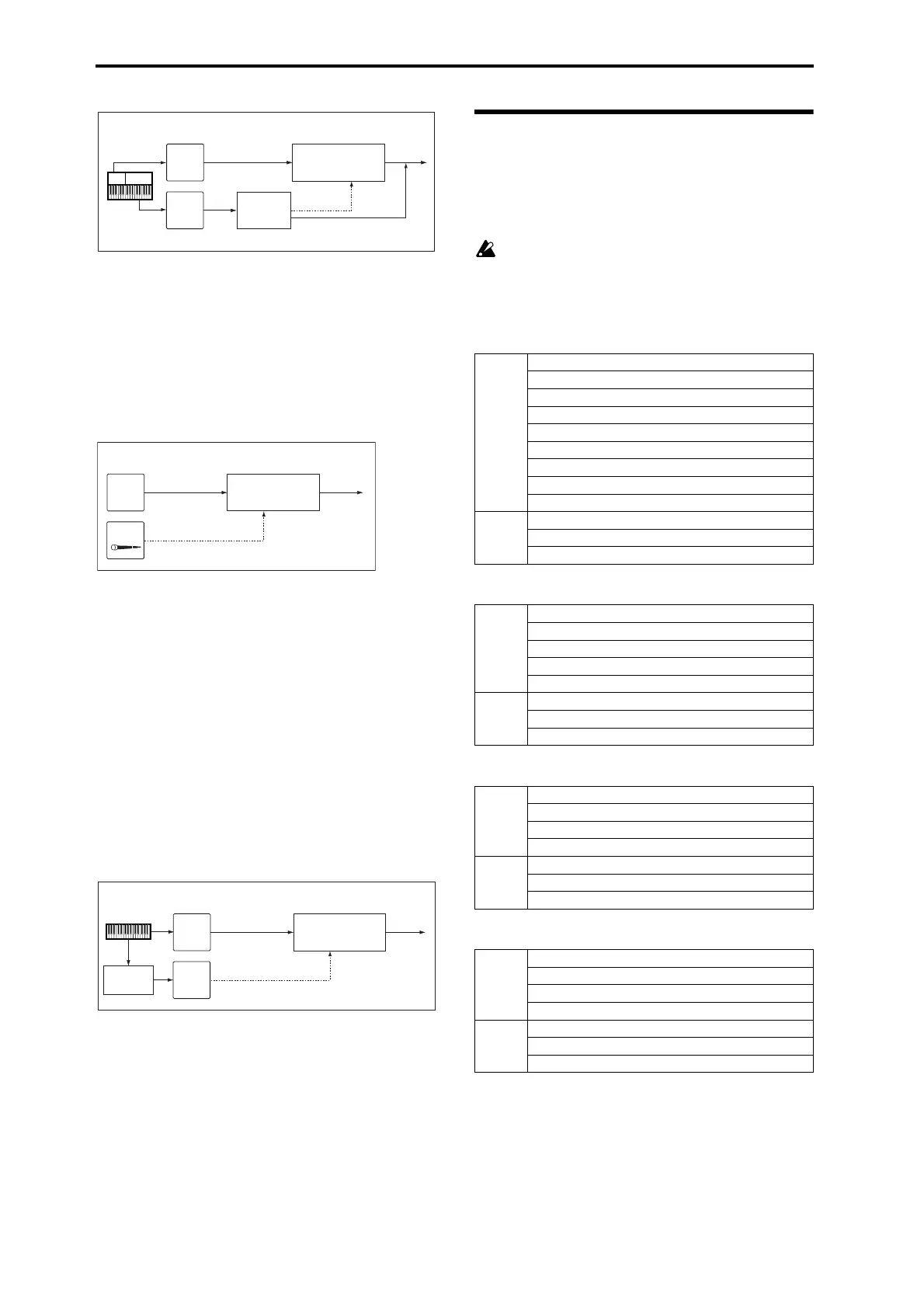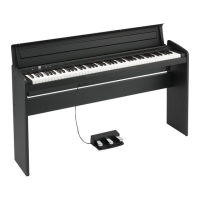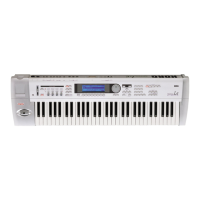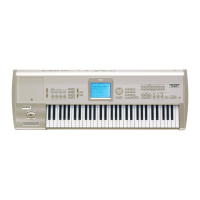Effect Guide
424
Example: Vocoder (Program)
Vocoder effects produce their distinctive sound by using an
audio signal (the modulator) to modulate a different audio
signal (the carrier). In the diagram, the output of OSC1 and 2
are the carrier, and the audio input from a mic is used as the
modulator to produce a “speaking instrument” type of
effect. Use Bus Select to send OSC1 and 2 (the carrier) to
IFX1, and set the FX Bus (0–7a) to 1 for the mic connected to
the AUDIO INPUT, and specify FX Control 1 as the
Modulator Source for IFX1: Vocoder.
Example: Rhythmic Vocoder (Combination)
Vocoder effects produce their distinctive sound by using an
audio signal (the modulator) to modulate a different audio
signal (the carrier). Although the most common application
of a vocoder is to use audio from a mic as the modulator,
you can also use a drum pattern or similar signal as the
modulator instead, producing a rhythm vocoder effect.
In the example shown in the diagram, a drum pattern
generated by KARMA and Drum Track function is sent to
the FX Control bus and used as the modulator for the
vocoder.
For timbre 1 (the carrier), set Bus Select to IFX1, sending the
signal to IFX1: Vocoder. For timbre 2 (the drum program
we’re using as the modulator), set FX Control Bus to 1,
sending the signal to FX Ctrl1 bus. For IFX1: Vocoder, set
“Modulator Source” to FX Control 1 so that the timbre 2
signal will be the modulator for the vocoder.
Effect I/O
To achieve the best tonal quality, signals sent to the effects
should be at the maximum level below clipping. Also, use
the Wet/Dry parameter for the Insert Effects, Total Effect and
the “Wet/Dry” or “Return 1, 2” parameter for the Master
Effects to adjust the effect output level.
If the input level is too low, the SN ratio may decrease.
On the other hand, if the input level is too high,
clipping may occur.
The following table shows the parameters related to the
level settings:
Program mode (EDS)
Program mode (optional EXB-RADIAS)
Combination mode/Sequencer mode
Sampling mode
IFX1
002: Stereo Limiter
Timbre1
: Pad
Bus Select
: IFX1
Ctrl Bus
(FX Control Bus)
: 1
Envelope Source
: FX Control 1
Limiter (Combination)
Bus Select
: L/R
(FX Control Bus1)
Timbre2
: Guitar
split
IFX2
018: OD/
Hi.Gain Wah
Bus Select
: IFX2
Bus Select
: L/R
Program
B
Program
A
IFX1
156: Vocoder
OSC1&2
Bus Select
: IFX1
FX Control Bus
: FX Ctrl1
Modulator Source
: FX Control 1
Vocoder (Program)
Bus Select
: L/R
(FX Control Bus1)
Audio
Input1
(Carrier)
(Modulator)
Mic
IFX1
156: Vocoder
Timbre1
: Pad
Bus Select
: IFX1
FX Control Bus
: 1
Modulator Source
: FX Control1
Rhythmic Vocoder (Combination)
Bus Select
: L/R
(FX Control Bus1)
(Carrier)
(Modulator)
Timbre2
: Drums
KARMA Drum
pattern/
Drum Track
Input
Control Surface OSC 1/2 Volume (P0)
OSC1/2 MS1, 2, 3, 4 Level (P2)
Filter1/2 Trim (P3)
Filter1/2 Output (P3)
Driver1/2 Drive (P4)
Amp1/2 Amp Level (P4)
EQ Input Trim (P4)
Send1/2 (P8)
Effect Trim parameter
*1
(P8, P9)
Output
Effect Wet/Dry parameter (P8, P9)
Return1, 2 (P9)
Master Volume (P9)
Input
Control Surface OSC Volume (P0)
OSC Mixer Level (OSC1 (OSC2, Noise) (P2)
Amp Level (P4)
Send1/2 (P8)
Effect Trim parameter
*1
(P8, P9)
Output
Effect Wet/Dry parameter (P8, P9)
Return1, 2 (P9)
Master Volume (P9)
Input
Volume (P0)
Timbre EQ Input Trim (P2)
Send1/2 (P8)
Effect Trim parameter
*1
(P8, P9)
Output
Effect Wet/Dry parameter (P8, P9)
Return1, 2 (P9)
Master Volume (P9)
Input
AUDIO INPUT LEVEL on the rear panel
Audio Input Level (P0)
Effect Trim parameter
*1
(P8, P9)
Send1/2 (P0, P8)
Output
Effect Wet/Dry parameter (P8, P9)
Return1, 2 (P9)
Master Volume (P9)

